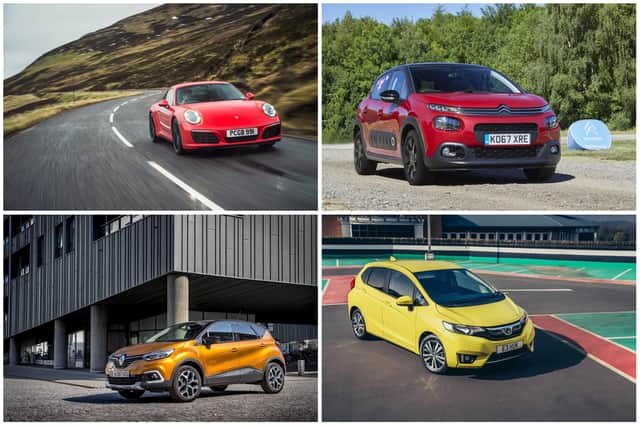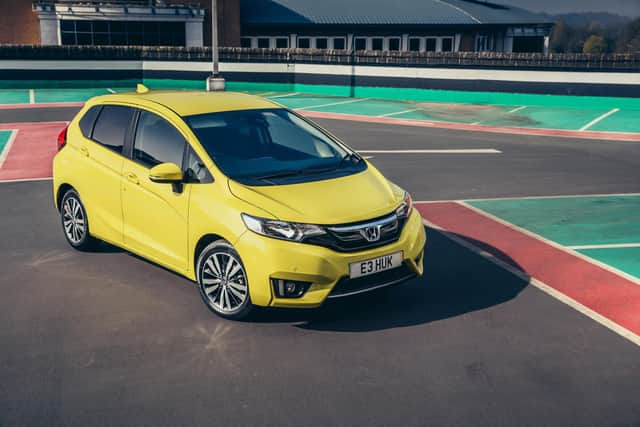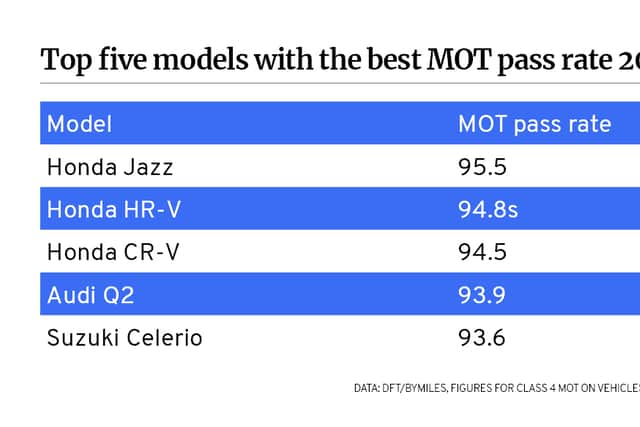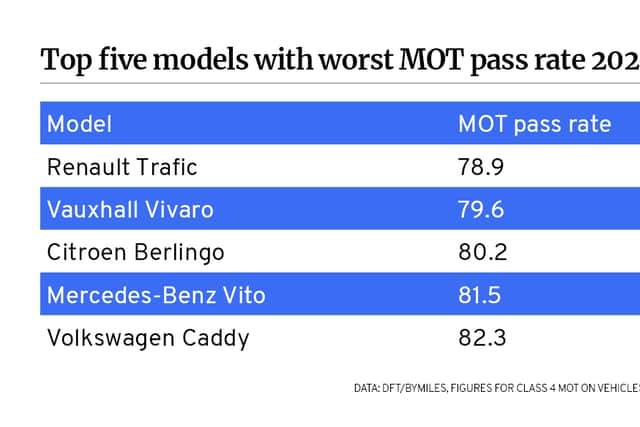The best car makes and models for MOT pass rates - and those most likely to fail test


MOT pass rates around Britain fell last year but Japanese brands continued to dominate the list of the makes and models most likely to breeze through the annual test, according to the latest figures.
Official data for the whole of 2021 show that pass rates dipped from 76.2% to 75.6% even though the average mileage of cars fell for the second year in a row, down to an average of just 5,398 miles.
Advertisement
Hide AdAdvertisement
Hide AdWhile pass rates and mileage fell, there was very little movement in terms of the best and worst modern vehicles, with the Honda Jazz once again emerging as the most likely to pass the MOT test.
The Japanese supermini topped the table among cars and light vans between three and five years old, with a pass rate of 95.5%. The new figures follow data from an independent warranty firm that shows the Jazz is also the most reliable car up to 10 years old.


The official Department for Transport data, obtained by insurer By Miles, shows that two other Honda models join the Jazz in the list of the five models with the best pass rates. The larger HR-V and CR-V SUVs claimed second and third spots on the list with pass rates of 94.8% and 94.5% respectively.
Another Japanese brand, Suzuki, took fifth spot with the Celerio supermini while Audi was the only European car brand to make it into the top five. The Q2 compact SUV showed an impressive pass rate of 93.9%, just ahead of the Celerio’s 93.6%.
Advertisement
Hide AdAdvertisement
Hide AdDespite no single model making it into the top five, Lexus was the best-performing brand overall, with an average pass rate of 94.7% across all its models. That was enough for it to snatch top place from Honda, which achieved a brand-wide average of 94.1%. Fellow Japanese brands Toyota (92.35%) and Suzuki (92.33%) also made it into the top five just behind Porsche, which had a brand average pass rate of 94%, despite its Cayenne and Panamera models making it into a recent rundown of the least dependable models.
While Japanese brands continued to show impressive reliability, the list of the worst performers was once again dominated by European brands and models. The data covering models from three to five years old makes particularly hard reading for the Stellantis group, which occupies four of the five worst brand spots.


Citroen and DS models were least likely to pass the MOT, with pass rates of 85.96% and 85.98% respectively. Both represent a slight improvement on 2020’s pass rates but still leave the two French brands at the bottom of the heap, just ahead of fellow French marque Renault, with a pass rate of 85.4%.
Renault’s sister brand Dacia managed to improve its standing compared with 2020, being replaced by Peugeot among the bottom five. Peugeot took fifth spot with a pass rate of 88.2%, just ahead of sister brand Vauxhall (87.5%).
Advertisement
Hide AdAdvertisement
Hide AdVauxhall, Citroen and Renault were also represented in the breakdown of the worst individual models. That list was dominated by light vans, which undergo the same Class 4 test as passenger cars.
The Renault Trafic was the worst overall performer, with a pass rate of 78.9%, just ahead of the Vauxhall Vivaro (79.6%). The Citroen Berlingo (80.2%) was just outperformed by the Mercedes-Benz Vito (81.5%) and Volkswagen Caddy (82.3%), suggesting that the harder life of a commercial vehicle takes its toll even after just a few years.


The MOT data also suggests drivers might be using their cars even less than previously. In 2020 when travel was disrupted by lockdowns and travel restrictions, the average mileage was 6,533 miles, a predictable drop from 2019’s 7,090 miles. Despite most restrictions easing in 2021 the average mileage fell further, dropping by another 1,135 miles to just 5,298.
James Blackham, CEO at By Miles, said: “It’s official, we’re now a nation of low mileage drivers. Many of us may have expected to see the UK’s annual average mileage bouncing back from the lows of the 2020 data, but our analysis shows the opposite.
“Even with more freedom in 2021, the average driver is now covering the equivalent of a round trip from Land’s End to John O’Groats (1,700 miles) less than they were in pre-pandemic times.”
Comment Guidelines
National World encourages reader discussion on our stories. User feedback, insights and back-and-forth exchanges add a rich layer of context to reporting. Please review our Community Guidelines before commenting.
